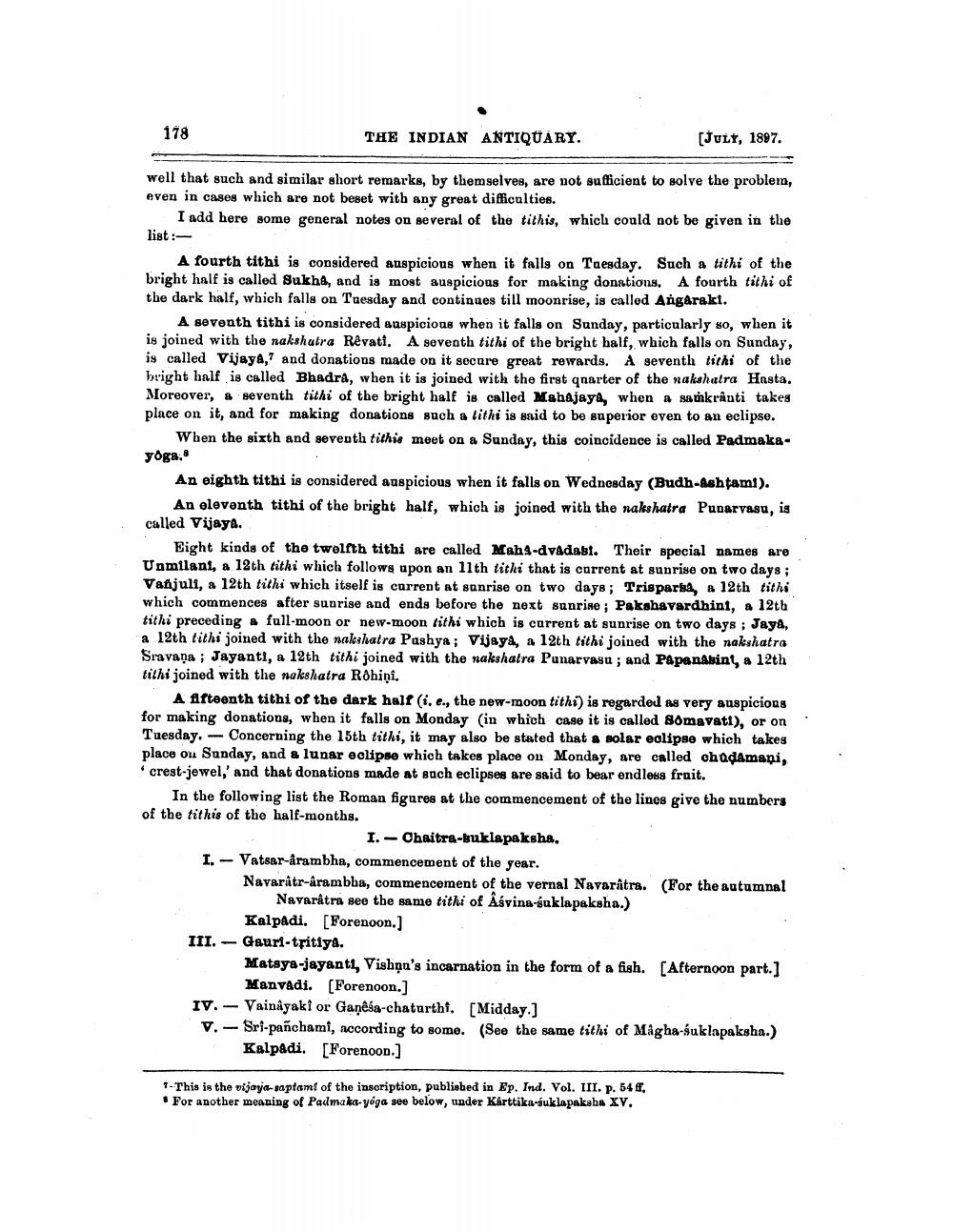________________
178
THE INDIAN ANTIQUARY.
[fuit, 1897.
well that such and similar short remarks, by themselves, are not sufficient to solve the problem, even in cases which are not beset with any great difficulties.
I add here some general notes on several of the tithis, which could not be given in the list:
A fourth tithi is considered auspicious when it falls on Tuesday. Such a tithi of the bright half is called Sukha, and is most auspicious for moking donations. A fourth tithi of the dark half, which falls on Tuesday and continues till moonrise, is called Angaraki.
A seventh tithi is considered auspicious when it falls on Sunday, particularly so, when it is joined with the nakshatra Rêvati. A seventh tithi of the bright half, which falls on Sunday, is called Vijaya,' and donations made on it secure great rewards. A seventh tithi of the bright half is called Bhadra, when it is joined with the first qnarter of the nakshatra Hasta. Moreover, & seventh tithi of the bright half is called Mahajaya, when a sankranti takes place on it, and for making donations such a lithi is said to be superior even to an eclipse.
When the sixth and seventh tithis meet on a Sunday, this coincidence is called Padmaka. yoga,
An eighth tithi is considered auspicious when it falls on Wednesday (Budh-Ashtami).
An eleventh tithi of the bright half, which is joined with the nakshatra Punarvasu, is called Vijaya.
Eight kinds of the twelfth tithi are called Mahi-dvadasi. Their special names are Unmilani, a 12th tithi which follows upon an 11th tithi that is current at sunrise on two days ; Vanjuli, a 12th tithi which itself is current at sonrise on two days; Trisparsa, a 12th tithi which commences after sunrise and ends before the next sunrise ; Pakshavardhini, a 12th tithi preceding a full-moon or new-moon tithi which is current at sunrise on two days ; Jaya, a 12th tithi joined with the nakshatra Pashya; Vijay,, a 12th tithi joined with the nakshatra Sravana ; Jayanti, a 12th tithi joined with the nakshatra Punarvasu ; and Papanakint, a 12th tithi joined with the nakshatra Robiņi.
A fifteenth tithi of the dark half (i, e., the new-moon tithi) is regarded as very auspicious for making donations, when it falls on Monday (in which case it is called Somavati), or on Tuesday. - Concerning the 15th tithi, it may also be stated that a solar eclipse which takes place ou Sunday, and a lunar eclipse which takes place on Monday, are called chadamani, crest-jewel,' and that donations made at such eclipses are said to bear endless fruit.
In the following list the Roman figures at the commencement of the lines give the numbers of the tithis of the half-months.
I. - Chaitra-buklapaksha. 1.- Vatsar-arambha, commencement of the year. Navaratr-arambba, commencement of the vernal Navaratra. (For the autumnal
Navarâtra see the same tithi of Asvina-suklapaksha.)
Kalpadi. [Forenoon.] III. - Gauri-tritiya.
Matsya-jayanti, Vishņu's incarnation in the form of a fish. (Afternoon part.]
Manvadi. (Forenoon.] IV. - Vainayaki or Gaņēša-chaturthi, [Midday.) V. - Sri-panchami, according to some. (See the same tithi of Magha-suklapaksha.)
Kalpadi. [Forenoon.]
1- This is the vijaya-saptame of the inscription, published in Ep. Ind. Vol. III. p. 54 ff. . For another meaning of Padmaka-yoga see below, under Karttika-buklapaksha XV.




